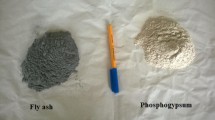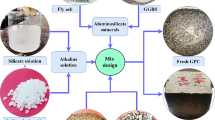Abstract
In the present work, compressive strength of inorganic polymers (geopolymers) made from seeded fly ash and rice husk bark ash has been predicted by artificial neural networks. Different specimens were subjected to compressive strength tests at 7 and 28 days of curing. One set of the specimens were cured at room temperature until reaching to 7 and 28 days, and the other sets were oven-cured for 36 h at the range of 40–90 °C and then room cured until 7 and 28 days. A model based on artificial neural networks for predicting the compressive strength of the specimens has been presented. To build the model, training and testing using experimental results from 120 specimens were conducted. The data used in the multilayer feed-forward neural networks models are arranged in a format of six input parameters that cover the percentage of fine fly ash in the ashes mixture, the percentage of coarse fly ash in the ashes mixture, the percentage of fine rice husk bark ash in the ashes mixture, the percentage of coarse rice husk bark ash in the ashes mixture, the temperature of curing, and the time of water curing. According to these input parameters, in the neural networks model, the compressive strength of each specimen was predicted. The training and testing results in the neural networks model have shown a strong potential for predicting the compressive strength of the geopolymer specimens.











Similar content being viewed by others
Change history
18 June 2020
The Editor-in-Chief has retracted this article [1] because it significantly overlaps with a number of articles including those that were under consideration at the same time [2], and previously published articles [3-6]. Additionally, the article shows evidence of peer review manipulation. The author has not responded to any correspondence regarding this retraction.
References
Wongpa J, Kiattikomol K, Jaturapitakkul C, Chindaprasirt P (2010) Compressive strength, modulus of elasticity, and water permeability of inorganic polymer concrete. Mater Design 31:4748–4754
Davidovits J (1991) Geopolymers: inorganic polymeric new materials. J Therm Anal 37:1633–1656
van Jaarsveld JGS, van Deventer JSJ, Lorenzen L (1997) The potential use of geopolymeric materials to immobilise toxic metals. Part I. Theory and applications. Miner Eng 10:659–669
Álvarez E, Querol X, Plan F, Alastuey A, Moreno N, Izquierdo M, Font O, Moreno T, Diez S, Vázquez E, Barra M (2008) Environmental, physical and structural characterisation of geopolymer matrixes synthesised from coal (co-)combustion fly ashes. J Hazard Mater 154:175–183
Sata V, Jaturapitakkul C, Kiattikomol K (2007) Influence of pozzolan from various byproduct materials on mechanical properties of high-strength concrete. Constr Build Mater 21(7):1589–1598
Tangchirapat W, Buranasing R, Jaturapitakkul C, Chindaprasirt P (2008) Influence of rice husk—bark ash on mechanical properties of concrete containing high amount of recycled aggregates. Constr Build Mater 22(8):1812–1819
Pala M, Ozbay O, Oztas A, Yuce MI (2005) Appraisal of long-term effects of fly ash and silica fume on compressive strength of concrete by neural networks. Constr Build Mater 21(2):384–394
Pak J, Jang J, Bhadeshia HKDH, Karlsson L (2009) Optimization of neural network for Charpy toughness of steel welds. Mater Manuf Process 24:16–21
Cottrell GA, Kemp R, Bhadeshia HKDH, Odette GR, Yamamoto T (2007) Neural network analysis of Charpy transition temperature of irradiated low-activation martensitic steels. J Nuclear Mater 367–370:603–609
Pacheco-Togal F, Castro-Gomes J, Jalali S (2007) Investigation about the effect of aggregates on strength and microstructure of geopolymeric mine waste mud binders. Cem Concr Res 37(6):933–941
Pacheco-Torgal F, Castro-Gomes JP, Jalali S (2005) Studies about mix composition of alkali-activated mortars using waste mud from Panasqueira. In: Proceedings of the engineering conference, University of Beira Interior, Covilha, Portugal
Bakharev T (2005) Geopolymeric materials prepared using Class F fly ash and elevated temperature curing. Cement Concr Res 35:1224–1232
Chindaprasirt P, Chareerat T, Sirivivatnanon V (2007) Workability and strength of coarse high calcium fly ash geopolymer. Cement Concr Comp 29:224–229
Zuhua Z, Xiao Y, Huajun Z, Yue C (2009) Role of water in the synthesis of calcined kaolin-based geopolymer. Appl Clay Sci 43(2):218–223
Fernandez-Jimenez A, Garcia-Lodeiro I, Palomo A (2007) Durability of alkali-activated fly ash cementitious materials. J Mater Sci 42(9):3055–3065
Van Jaarsveld JGS, Van Deventer JSJ, Lukey GC (2002) The effect of composition and temperature on the properties of fly ash—and kaolinite-based geopolymers. Chem Eng J 89(1–3):63–73
Givi AN, Rashid SA, Aziz FNA, Mohd Salleh MA (2010) Assessment of the effects of rice husk ash particle size on strength, water permeability and workability of binary blended concrete. Constr Build Mater 24(11):2145–2150
Duxson P, Mallicoat SW, Lukey GC, Kriven WM, van Deventer JSJ (2007) The effect of alkali and Si/Al ratio on the development of mechanical properties of metakaolin-based geopolymers. Colloid Surf A 292(1):8–20
Topcu IB, Karakurt C, Sarıdemir M (2008) Predicting the strength development of cements produced with different pozzolans by neural network and fuzzy logic. Mater Design 29:1986–1991
Ince R (2004) Prediction of fracture parameters of concrete by artificial neural networks. Eng Fract Mech 71(15):2143–2159
Sarıdemir M, Topcu IB, Ozcan F, Severcan MH (2009) Prediction of long-term effects of GGBFS on compressive strength of concrete by artificial neural networks and fuzzy logic. Constr Build Mater 23:1279–1286
Liu SW, Huang JH, Sung JC, Lee CC (2002) Detection of cracks using neural networks and computational mechanics. Comput Meth Appl Mech Eng 191(25–26):2831–2845
Gunaydın HM, Dogan SZ (2004) A neural network approach for early cost estimation of structural systems of building. Int J Project Manage 22(7):595–602
Suratgar AA, Tavakoli MB, Hoseinabadi A (2005) Modified Levenberg–Marquardt method for neural networks training. World Acad Sci Eng Technol 6:46–48
Guzelbey IH, Cevik A, Erklig A (2006) Prediction of web crippling strength of cold-formed steel sheetings using neural networks. J Constr Steel Res 62:962–973
Topcu IB, Saridemir M (2008) Prediction of compressive strength of concrete containing fly ash using artificial neural network and fuzzy logic. Comp Mater Sci 41(3):305–311
Author information
Authors and Affiliations
Corresponding author
Additional information
The Editor-in-Chief has retracted this article because it significantly overlaps with a number of articles including those that were under consideration at the same time, and previously published articles. Additionally, the article shows evidence of peer review manipulation. The author has not responded to any correspondence regarding this retraction.
About this article
Cite this article
Nazari, A. RETRACTED ARTICLE: Artificial neural networks for prediction compressive strength of geopolymers with seeded waste ashes. Neural Comput & Applic 23, 391–402 (2013). https://doi.org/10.1007/s00521-012-0931-4
Received:
Accepted:
Published:
Issue Date:
DOI: https://doi.org/10.1007/s00521-012-0931-4




